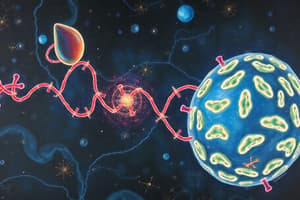Podcast
Questions and Answers
Which stage of cellular respiration does not require oxygen?
Which stage of cellular respiration does not require oxygen?
- Glycolysis (correct)
- Krebs cycle
- Oxidative phosphorylation
- Pyruvate oxidation
The Krebs cycle produces ATP, NADH, and FADH2.
The Krebs cycle produces ATP, NADH, and FADH2.
True (A)
What is the primary energy currency of cells?
What is the primary energy currency of cells?
ATP
Pyruvate is converted into __________ during pyruvate oxidation.
Pyruvate is converted into __________ during pyruvate oxidation.
What is the main function of the electron transport chain?
What is the main function of the electron transport chain?
Match the following stages of cellular respiration with their main characteristics:
Match the following stages of cellular respiration with their main characteristics:
Fermentation occurs in the presence of oxygen.
Fermentation occurs in the presence of oxygen.
The majority of ATP produced in cellular respiration occurs during __________.
The majority of ATP produced in cellular respiration occurs during __________.
Flashcards
ATP - The cell's energy currency
ATP - The cell's energy currency
ATP (adenosine triphosphate) is the primary molecule used by cells to store and release energy for various processes like muscle contraction, protein synthesis, and active transport.
Cellular Respiration: Glucose Breakdown
Cellular Respiration: Glucose Breakdown
Cellular respiration is a series of metabolic reactions that break down glucose (sugar) to produce ATP. It occurs in eukaryotes and involves four major stages: glycolysis, pyruvate oxidation, the Krebs cycle, and oxidative phosphorylation.
Glycolysis: The First Step
Glycolysis: The First Step
Glycolysis is the first stage of cellular respiration. It occurs in the cytoplasm and breaks down glucose into two pyruvate molecules, yielding a small amount of ATP (2 net ATP) and NADH. Importantly, glycolysis does not require oxygen.
Pyruvate Oxidation: Prepping for the Krebs Cycle
Pyruvate Oxidation: Prepping for the Krebs Cycle
Signup and view all the flashcards
Krebs Cycle (Citric Acid Cycle): The Central Hub
Krebs Cycle (Citric Acid Cycle): The Central Hub
Signup and view all the flashcards
Oxidative Phosphorylation: The Big ATP Producer
Oxidative Phosphorylation: The Big ATP Producer
Signup and view all the flashcards
Fermentation: Anaerobic ATP Production
Fermentation: Anaerobic ATP Production
Signup and view all the flashcards
Factors Affecting ATP Production
Factors Affecting ATP Production
Signup and view all the flashcards
Study Notes
ATP Production: Overview
- ATP (adenosine triphosphate) is the primary energy currency of cells. It stores and releases energy for various cellular processes.
- ATP production occurs through various metabolic pathways, primarily cellular respiration in eukaryotes.
- Cellular respiration involves a series of reactions that break down glucose to produce ATP.
- ATP production is tightly regulated to meet the cell's energy demands.
Cellular Respiration: Stages
- Cellular respiration comprises four main stages:
- Glycolysis
- Pyruvate oxidation
- Krebs cycle (citric acid cycle)
- Oxidative phosphorylation (electron transport chain and chemiosmosis).
Glycolysis
- Occurs in the cytoplasm.
- Breaks down glucose (6 carbons) into two pyruvate molecules (3 carbons each).
- Yields a small amount of ATP (2 net ATP) and NADH.
- Does not require oxygen (anaerobic).
Pyruvate Oxidation
- Occurs in the mitochondrial matrix.
- Converts pyruvate into Acetyl-CoA.
- Produces NADH and releases carbon dioxide.
- This step links glycolysis to the Krebs cycle.
Krebs Cycle (Citric Acid Cycle)
- Occurs in the mitochondrial matrix.
- Acetyl-CoA enters the cycle, releasing carbon dioxide.
- Produces ATP, NADH, FADH2, and more carbon dioxide.
- The cycle turns twice for each glucose molecule.
Oxidative Phosphorylation
- Involves the electron transport chain and chemiosmosis.
- Located in the inner mitochondrial membrane.
- NADH and FADH2 donate electrons to the electron transport chain.
- Electrons move through a series of protein complexes, releasing energy to pump protons (H+) across the membrane.
- This creates a proton gradient.
- Chemiosmosis uses the energy stored in the proton gradient to drive ATP synthesis by ATP synthase.
- Yields the majority of ATP produced in cellular respiration (about 28-34 ATP).
Alternative Energy Production Pathways
- Fermentation (anaerobic): Provides ATP from glucose when oxygen is scarce. Lactic acid fermentation in animals and alcohol fermentation in yeast are examples.
- Other molecules (e.g., lipids, proteins) can also be broken down to produce ATP via similar pathways, with adjustments in the input and process steps. These alternate pathways can be used to produce ATP when glucose is not available.
Factors Affecting ATP Production
- Availability of substrates (glucose, fats, proteins).
- Oxygen levels (crucial for oxidative phosphorylation).
- Regulation by enzymes and energy demand of the cell.
Regulation of ATP Production
- Cells tightly regulate ATP production to meet their energy demands.
- Feedback mechanisms control the activity of enzymes involved in ATP production.
- The levels of ATP, ADP, and AMP are important indicators in regulating metabolic pathways.
- Energy availability regulates the rate of ATP production, ensuring cells do not consume more energy than needed.
Studying That Suits You
Use AI to generate personalized quizzes and flashcards to suit your learning preferences.




